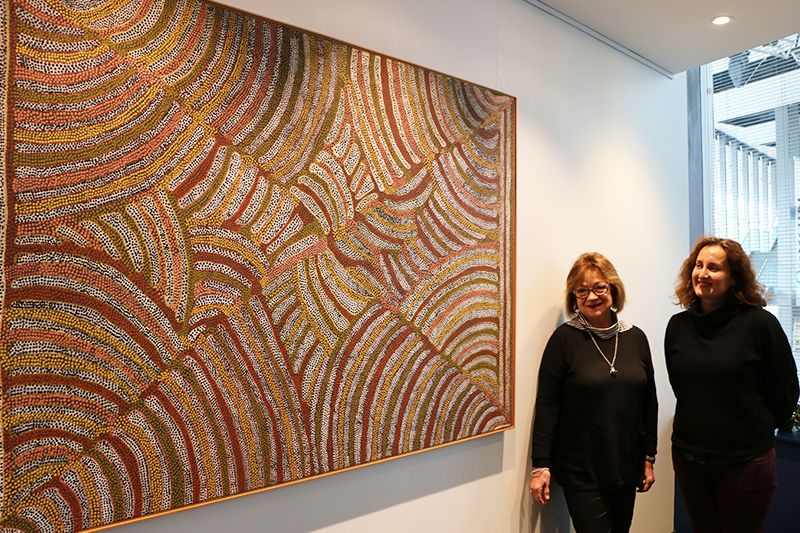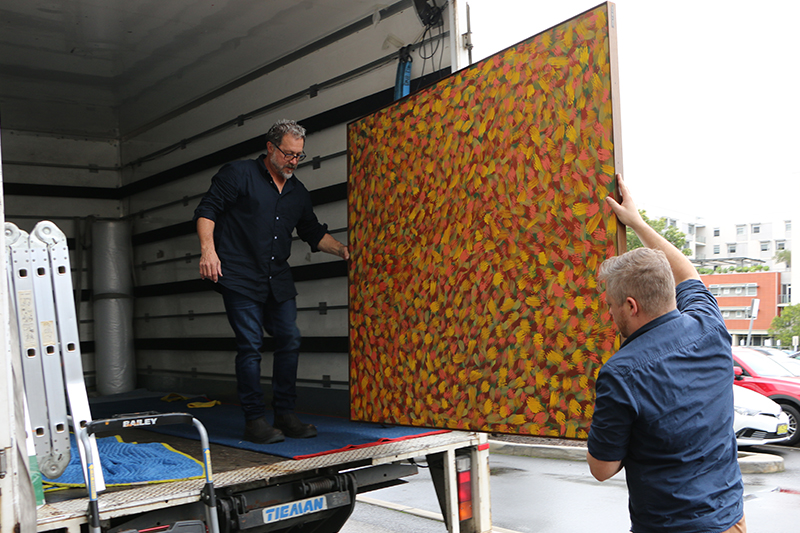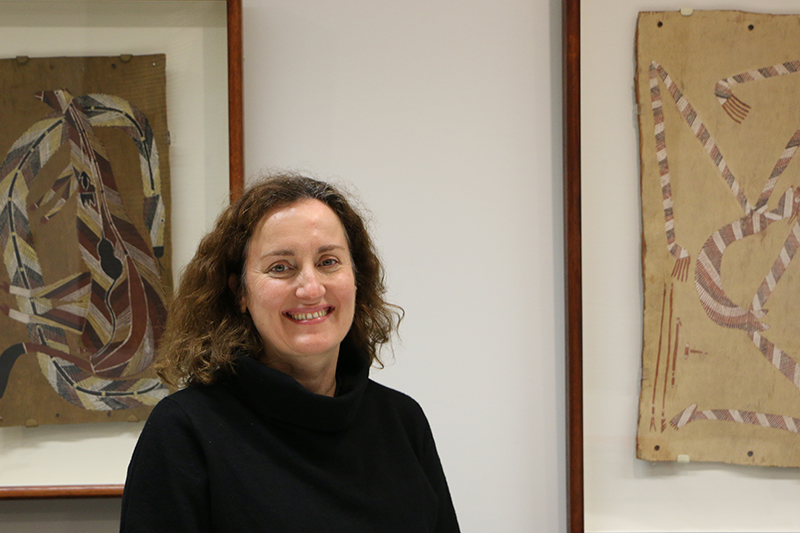NIDA welcomes stunning Indigenous artworks, on loan from UNSW’s Art Collection.

Photo: NIDA Chief Executive Officer Jennifer Bott AO and Elena Taylor, senior curator UNSW Art Unit with Awelye byGloria Tamerre Petyarre.
NIDA Chief Executive Officer Jennifer Bott AO welcomed Indigenous artworks to be hung in the Kensington campus for two years as part of the celebration of NAIDOC Week 2019.
The stunning artworks are on loan from the UNSW Art Collection, and were brought over to the building by Elena Taylor, senior curator UNSW Art Unit and art handlers Christian Flynn and Mark Gumley from Pod Museum and Art Services. The works include paintings on canvas and bark work created in natural ochres and are hung throughout the building.
The artists represented are Gloria Tamerre Petyarre, Djawida Nadjongorle, Yuwati (Central Arnhem Land, attributed to) andRobert Burrarnu.

Photo: The artworks arrive. Gloria Tamerre Petyarre’s workLeaves is handled carefully into NIDA.

Photo: Elena Taylor, senior curator UNSW Art Unit at NIDA, with Djawida Nadjongorle’s bark paintings Kangaroo And Rainbow Serpent and Namorodo.
About the artists and artworks
Gloria Tamerre Petyarre
Gloria Tamerre Petyarre (birth date given variously from 1938 to 1945) is an Anmatyerre woman and leading artist from the Utopia community, approximately 250 kms north-east of Alice Springs. Like her kinswoman Emily Kame Kngwarreye, Petyarre began her art making in the late 1970s when the Utopia women were introduced to batik and other dying and textile painting techniques. She was a founding member of the Utopia Batik Group, whose work became an important industry for the Anmatyerre following the return of Utopia to its traditional owners in 1978.
Petyarre began painting on canvas in 1988, and in 1999, she was the first Indigenous artist to be awarded the Wynne Prize for Landscape at the Art Gallery of New South Wales. Her densely patterned paintings of swirling leaves represent the leaves of the Kurrajong tree which are used for their medicinal properties. She has exhibited widely in Australia, Europe, North America and Asia and her paintings and prints are in the collections of public institutions including the National Gallery of Australia, National Gallery of Victoria and the Art Gallery of New South Wales.
Djawida Nadjongorle Renowned artist Djawida Nadjongorle (c.1943-2008) was a Kunwinjku language speaker from West Arnhem Land. He was born on his father’s country at Dialbangurr, and as a child moved with his family to the Gunbalanya (Oenpelli) community, approximately 330 kilometres east of Darwin, where his mother and father worked as buffalo skinners and salters. On visits with his family to the rock escarpments of their traditional lands, Nadjongorle first started to paint on rock, copying existing rock paintings, especially animals and the stick-like mimih spirits.
Nadjongorle began painting on bark in the late 1960s, painting stories from his father’s country at Djalbangurr, his mother’s country at Kudjekbinj, and sometimes his grandmother’s country near Manmoyi. His paintings show the influence of the visual language of their rock-art heritage, and often feature mimihs and other spirit figures in expressive poses suggesting action. In 1985 he was the joint winner of the National Aboriginal and Torres Strait Islander Art Award and his works are held in numerous public collections including the National Gallery of Australia and the National Gallery of Victoria.
Attributed to Yuwati (Central Arnhem Land)
According to the beliefs of the Yolngu people of Central and North Eastern Arnhem Land, during the Wangarr, the Ancestral period which is ongoing into the present and into the future, the Creator Ancestors made their journeys across the land. These Ancestor beings – which can take human or animal form – created the plants and animals, gave birth to the people and gave them their land, languages, ceremonies, sacred designs and law. Their exploits make up the creation stories which are the most important subjects of Yolngu art.
This painting is connected with the Birrkili Ceremony and depicts two turtles who after mating were hunting for shellfish in the Banyan creek. They became angry when they could not reach the shellfish who were hiding in the rocks and called to the great Snake for assistance. The Snake sent a violent storm which caused the creek to flood, and the turtles ate the shellfish. According to people of the Yirritja moiety this is how the first wet season was created.
Robert Burrarnu
Maningrida, in Central Arnhem Land, about 500 kilometres east of Darwin is home to several clan and language groups including the Yolngu-speaking Djinang people. Burrarnu’s painting depicts Gartjarmbal, the large Grey Kangaroo and the sacred totem of the Djinang clan, cut up into pieces for cooking in the fire.
The work is covered with an intricate pattern of geometric sacred clan designs known as Miny’tji which is characteristic of Yolngu art. These designs are sacred and are considered to have been handed down directly from the Creator Ancestors to individual clans and are the same designs that are painted onto people as part of initiation ceremonies. Covering the entire surface of the work, fine areas of cross-hatching create an effect of optical shimmer known as Bir’yun which is considered a manifestation of Ancestral Power. Art is an important means for the Yolngu to express their cultural and political identity, to assert ownership of their traditional lands and to increase understanding and appreciation of their culture and worldview to a balanda (non-Yolngu) audience.
More information about the UNSW Art Collection here.

